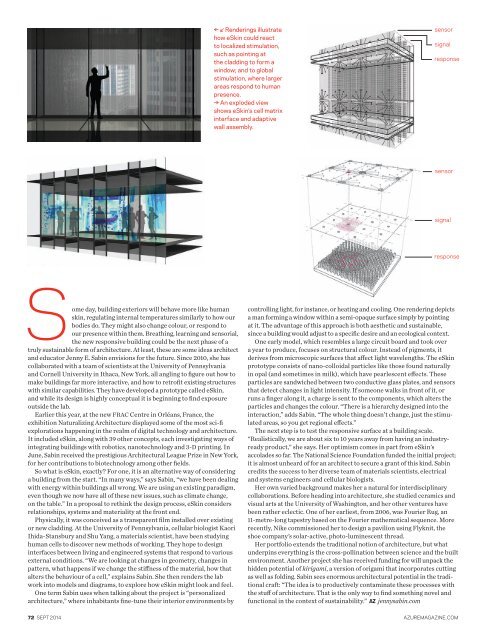AZURE_2014_09.pdf
Create successful ePaper yourself
Turn your PDF publications into a flip-book with our unique Google optimized e-Paper software.
← ↘Renderings illustrate<br />
how eSkin could react<br />
to localized stimulation,<br />
such as pointing at<br />
the cladding to form a<br />
window; and to global<br />
stimulation, where larger<br />
areas respond to human<br />
presence.<br />
→ An exploded view<br />
shows eSkin’s cell matrix<br />
interface and adaptive<br />
wall assembly.<br />
sensor<br />
signal<br />
response<br />
sensor<br />
signal<br />
response<br />
Some day, building exteriors will behave more like human<br />
skin, regulating internal temperatures similarly to how our<br />
bodies do. They might also change colour, or respond to<br />
our presence within them. Breathing, learning and sensorial,<br />
the new responsive building could be the next phase of a<br />
truly sustainable form of architecture. At least, these are some ideas architect<br />
and educator Jenny E. Sabin envisions for the future. Since 2010, she has<br />
collaborated with a team of scientists at the University of Pennsylvania<br />
and Cornell University in Ithaca, New York, all angling to figure out how to<br />
make buildings far more interactive, and how to retrofit existing structures<br />
with similar capabilities. They have developed a proto type called eSkin,<br />
and while its design is highly conceptual it is beginning to find exposure<br />
outside the lab.<br />
Earlier this year, at the new FRAC Centre in Orléans, France, the<br />
exhibition Naturalizing Architecture displayed some of the most sci-fi<br />
explorations happening in the realm of digital technology and architecture.<br />
It included eSkin, along with 39 other concepts, each investigating ways of<br />
integrating buildings with robotics, nanotechnology and 3‐D printing. In<br />
June, Sabin received the prestigious Architectural League Prize in New York,<br />
for her contributions to biotechnology among other fields.<br />
So what is eSkin, exactly? For one, it is an alternative way of considering<br />
a building from the start. “In many ways,” says Sabin, “we have been dealing<br />
with energy within buildings all wrong. We are using an existing paradigm,<br />
even though we now have all of these new issues, such as climate change,<br />
on the table.” In a proposal to rethink the design process, eSkin considers<br />
relationships, systems and materiality at the front end.<br />
Physically, it was conceived as a transparent film installed over existing<br />
or new cladding. At the University of Pennsylvania, cellular biologist Kaori<br />
Ihida-Stansbury and Shu Yang, a materials scientist, have been studying<br />
human cells to discover new methods of working. They hope to design<br />
interfaces between living and engineered systems that respond to various<br />
external conditions. “We are looking at changes in geometry, changes in<br />
pattern, what happens if we change the stiffness of the material, how that<br />
alters the behaviour of a cell,” explains Sabin. She then renders the lab<br />
work into models and diagrams, to explore how eSkin might look and feel.<br />
One term Sabin uses when talking about the project is “personalized<br />
architecture,” where inhabitants fine-tune their interior environments by<br />
controlling light, for instance, or heating and cooling. One rendering depicts<br />
a man forming a window within a semi-opaque surface simply by pointing<br />
at it. The advantage of this approach is both aesthetic and sustainable,<br />
since a building would adjust to a specific desire and an ecological context.<br />
One early model, which resembles a large circuit board and took over<br />
a year to produce, focuses on structural colour. Instead of pigments, it<br />
derives from microscopic surfaces that affect light wavelengths. The eSkin<br />
prototype consists of nano- colloidal particles like those found naturally<br />
in opal (and sometimes in milk), which have pearlescent effects. These<br />
particles are sandwiched between two conductive glass plates, and sensors<br />
that detect changes in light intensity. If someone walks in front of it, or<br />
runs a finger along it, a charge is sent to the components, which alters the<br />
particles and changes the colour. “There is a hierarchy designed into the<br />
interaction,” adds Sabin. “The whole thing doesn’t change, just the stimulated<br />
areas, so you get regional effects.”<br />
The next step is to test the responsive surface at a building scale.<br />
“Realistically, we are about six to 10 years away from having an industryready<br />
product,” she says. Her optimism comes in part from eSkin’s<br />
accolades so far. The National Science Foundation funded the initial project;<br />
it is almost unheard of for an architect to secure a grant of this kind. Sabin<br />
credits the success to her diverse team of materials scientists, electrical<br />
and systems engineers and cellular biologists.<br />
Her own varied background makes her a natural for interdisciplinary<br />
collaborations. Before heading into architecture, she studied ceramics and<br />
visual arts at the University of Washington, and her other ventures have<br />
been rather eclectic. One of her earliest, from 2006, was Fourier Rug, an<br />
11-metre-long tapestry based on the Fourier mathematical sequence. More<br />
recently, Nike commissioned her to design a pavilion using Flyknit, the<br />
shoe company’s solar-active, photo-luminescent thread.<br />
Her portfolio extends the traditional notion of architecture, but what<br />
underpins everything is the cross-pollination between science and the built<br />
environment. Another project she has received funding for will unpack the<br />
hidden potential of kirigami, a version of origami that incorporates cutting<br />
as well as folding. Sabin sees enormous architectural potential in the traditional<br />
craft: “The idea is to productively contaminate these processes with<br />
the stuff of architecture. That is the only way to find something novel and<br />
functional in the context of sustainability.” jennysabin. com<br />
72 sept <strong>2014</strong> azuremagazine.com


















